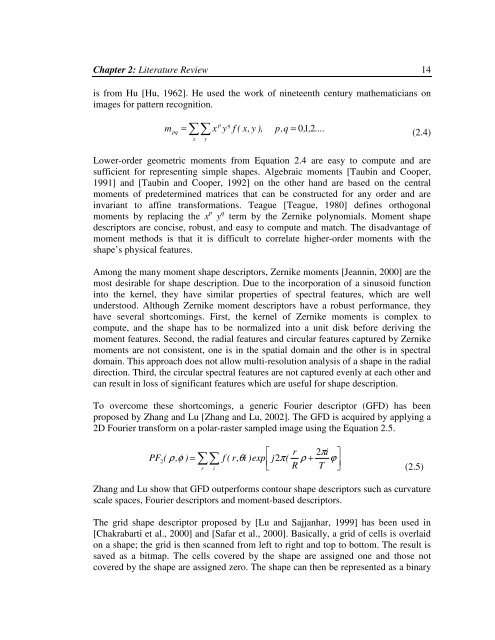To the Graduate Council: I am submitting herewith a thesis written by ...
To the Graduate Council: I am submitting herewith a thesis written by ...
To the Graduate Council: I am submitting herewith a thesis written by ...
Create successful ePaper yourself
Turn your PDF publications into a flip-book with our unique Google optimized e-Paper software.
Chapter 2: Literature Review 14is from Hu [Hu, 1962]. He used <strong>the</strong> work of nineteenth century ma<strong>the</strong>maticians onimages for pattern recognition.p qmpq = x y f ( x, y ), p,q = 0 , 1,2....x y(2.4)Lower-order geometric moments from Equation 2.4 are easy to compute and aresufficient for representing simple shapes. Algebraic moments [Taubin and Cooper,1991] and [Taubin and Cooper, 1992] on <strong>the</strong> o<strong>the</strong>r hand are based on <strong>the</strong> centralmoments of predetermined matrices that can be constructed for any order and areinvariant to affine transformations. Teague [Teague, 1980] defines orthogonalmoments <strong>by</strong> replacing <strong>the</strong> x p y q term <strong>by</strong> <strong>the</strong> Zernike polynomials. Moment shapedescriptors are concise, robust, and easy to compute and match. The disadvantage ofmoment methods is that it is difficult to correlate higher-order moments with <strong>the</strong>shape’s physical features.Among <strong>the</strong> many moment shape descriptors, Zernike moments [Jeannin, 2000] are <strong>the</strong>most desirable for shape description. Due to <strong>the</strong> incorporation of a sinusoid functioninto <strong>the</strong> kernel, <strong>the</strong>y have similar properties of spectral features, which are wellunderstood. Although Zernike moment descriptors have a robust performance, <strong>the</strong>yhave several shortcomings. First, <strong>the</strong> kernel of Zernike moments is complex tocompute, and <strong>the</strong> shape has to be normalized into a unit disk before deriving <strong>the</strong>moment features. Second, <strong>the</strong> radial features and circular features captured <strong>by</strong> Zernikemoments are not consistent, one is in <strong>the</strong> spatial domain and <strong>the</strong> o<strong>the</strong>r is in spectraldomain. This approach does not allow multi-resolution analysis of a shape in <strong>the</strong> radialdirection. Third, <strong>the</strong> circular spectral features are not captured evenly at each o<strong>the</strong>r andcan result in loss of significant features which are useful for shape description.<strong>To</strong> overcome <strong>the</strong>se shortcomings, a generic Fourier descriptor (GFD) has beenproposed <strong>by</strong> Zhang and Lu [Zhang and Lu, 2002]. The GFD is acquired <strong>by</strong> applying a2D Fourier transform on a polar-raster s<strong>am</strong>pled image using <strong>the</strong> Equation 2.5.PF ( ρ,φ ) =2 r 2πif ( r, θi)expj2π( ρ + ϕ Rr i T(2.5)Zhang and Lu show that GFD outperforms contour shape descriptors such as curvaturescale spaces, Fourier descriptors and moment-based descriptors.The grid shape descriptor proposed <strong>by</strong> [Lu and Sajjanhar, 1999] has been used in[Chakrabarti et al., 2000] and [Safar et al., 2000]. Basically, a grid of cells is overlaidon a shape; <strong>the</strong> grid is <strong>the</strong>n scanned from left to right and top to bottom. The result issaved as a bitmap. The cells covered <strong>by</strong> <strong>the</strong> shape are assigned one and those notcovered <strong>by</strong> <strong>the</strong> shape are assigned zero. The shape can <strong>the</strong>n be represented as a binary
















